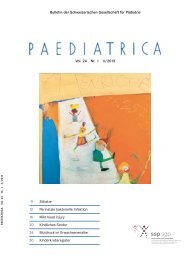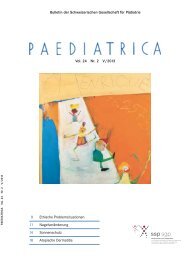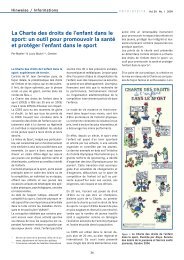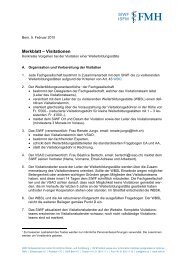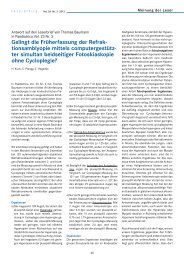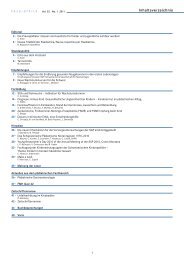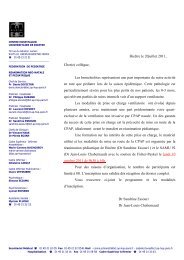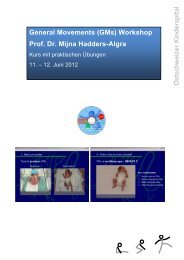Smartphone Version - Société suisse de pédiatrie
Smartphone Version - Société suisse de pédiatrie
Smartphone Version - Société suisse de pédiatrie
Sie wollen auch ein ePaper? Erhöhen Sie die Reichweite Ihrer Titel.
YUMPU macht aus Druck-PDFs automatisch weboptimierte ePaper, die Google liebt.
Fortbildung<br />
Vol. 23 Nr. 1 2012<br />
Eine Registerkoordinatorin wird in regelmässigen<br />
Abstän<strong>de</strong>n Dateneingabe und <strong>de</strong>ren<br />
Vollständigkeit prüfen sowie das Follow-up<br />
koordinieren helfen.<br />
Zusammenfassung<br />
Zusammenfassend kann gesagt wer<strong>de</strong>n,<br />
dass die Einführung <strong>de</strong>r Hypothermiebehandlung<br />
für Kin<strong>de</strong>r mit einer HIE neue<br />
Hoffnungen weckt. Die Hypothermiebehandlung<br />
soll jedoch innerhalb von 6 Stun<strong>de</strong>n<br />
nach <strong>de</strong>m asphyktischen Ereignis begonnen<br />
wer<strong>de</strong>n, es ist <strong>de</strong>shalb wesentlich, dass die<br />
entsprechen<strong>de</strong>n Patienten innerhalb dieses<br />
Zeitabschnittes an ein Neonatologiezentrum<br />
Niveau III zugewiesen wer<strong>de</strong>n. Die Einführung<br />
eines nationalen Asphyxieregisters erlaubt<br />
es, kurz- und langfristige Nebenwirkungen,<br />
sowie auch schweizweit genauere<br />
epi<strong>de</strong>miologische Daten, die bisher weitgehend<br />
fehlen, zu erfassen.<br />
Diese Therapie kann nur im Zusammenhang<br />
mit einer guten Antizipation geburtshilflicher<br />
Komplikationen und einer optimalen neonatalen<br />
Reanimation betrachtet wer<strong>de</strong>n. Eine<br />
gründliche Ausbildung in neonataler Reanimation<br />
aller Ärzte, die Neugeborene betreuen,<br />
muss <strong>de</strong>shalb ein gesundheitspolitisches<br />
Ziel sein.<br />
their Relevance to Perinatal Brain Damage. In «Perinatal<br />
Brain Damage: from Pathogenesis to Neuroprotection»,<br />
chapter 3, Eds: L. A. Ramenghi, P.<br />
Evrard and E. Mercuri. Mariani Foundation Paediatric<br />
Neurology Series 19, John Libbey Eurotext,<br />
Montrouge, France. 2008.<br />
10) Ginet V, Puyal J, Clarke PG and Truttmann AC. Enhancement<br />
of Autophagic Flux after Neonatal Cerebral<br />
Hypoxia-Ischemia and Its Region-Specific<br />
Relationship to Apoptotic Mechanisms. American<br />
J of Pathology 2009; 175 (5): 1–13.<br />
11) Puyal J, Ginet V, Vaslin A, Truttmann AC, Clarke<br />
PGH. The two faces of autophagy in the nervous<br />
system. Me<strong>de</strong>cine Science. 2009; 25 (4): 383–390.<br />
12) Thoresen M, Penrice J, Lorek A, et al. Mild hypothermia<br />
after severe transient hypoxia-ischemia ameliorates<br />
<strong>de</strong>layed cerebral energy failure in the<br />
newborn piglet. Pediatr Res 1995; 37: 667–70.<br />
13) Sarnat HB et Sarnat MS. Neonatal encephalopathy<br />
following fetal distress. A clinical and electroencephalographic<br />
study. Arch Neurol. 1976; 33 (10):<br />
696–705.<br />
14) Thompson CM, Puterman AS, Linley LL, Hann FM,<br />
van <strong>de</strong>r Elst CW, Molteno CD, Malan AF. The value<br />
of a scoring system for hypoxic ischaemic encephalopathy<br />
in predicting neuro<strong>de</strong>velopmental outcome.<br />
Acta Paediatr. 1997; 86 (7): 757–61.<br />
15) Rennie J, Hagmann CF et Robertson NJ. The baby<br />
who was <strong>de</strong>pressed at birth, in «Neonatal Cerebral<br />
Investigation», Chapter 8, pp 130–172. Cambridge<br />
Medicine, Cambridge University press, second<br />
edition 2008.<br />
16) Robertson NJ, Kendall GS, Thayyil S. Techniques for<br />
therapeutic hypothermia during transport and in<br />
hospital for perinatal asphyxial encephalopathy.<br />
Semin Fetal Neonatal Med. 2010; 15 (5): 276–86.<br />
17) Strohm B, Azzopardi D; UK TOBY Cooling Register<br />
Study Group. Temperature control during therapeutic<br />
mo<strong>de</strong>rate whole-body hypothermia for neonatal<br />
encephalopathy. Arch Dis Child Fetal Neonatal<br />
Ed. 2010; 95 (5): F 373–5.<br />
Referenzen<br />
1) García-Alix A, Martínez-Biarge M, Diez J, Gayá F.<br />
Neonatal hypoxic-ischemic encephalopathy: Inci<strong>de</strong>nce<br />
and prevalence in the first <strong>de</strong>ca<strong>de</strong> of the 21st<br />
century. An Pediatr. 2009; 71 (4): 319–26.<br />
2) Volpe JJ. Perinatal brain injury: from pathogenesis<br />
to neuroprotection. Ment Retard Dev Disabil Res<br />
Rev. 2001; 7 (1): 56–64.<br />
3) Perlman JM. Intervention strategies for neonatal<br />
hypoxic-ischemic cerebral injury. Clin Ther. 2006;<br />
28 (9): 1353–65.<br />
4) Shankaran S, Laptook AR, Ehrenkranz RA et al.<br />
Whole-Body Hypothermia for Neonates with Hypoxic–Ischemic<br />
Encephalopathy. N Engl J Med 2005;<br />
353: 1574–84.<br />
5) Azzopardi DV, Strohm B, Edwards AD et al; the<br />
TOBY study group. Mo<strong>de</strong>rate Hypothermia to Treat<br />
Perinatal Asphyxial Encephalopathy. N Engl J Med<br />
2009; 361: 1349–58.<br />
6) Shankaran Seetha. Neonatal encephalopathy:<br />
treatment with hypothermia. Journal of neurotrauma<br />
2009; 26: 437–43.<br />
7) Gluckman PD, Wyatt JS, Azzopardi D, Ballard R, and<br />
the cool cap trial group. Selective head cooling with<br />
mild systemic hypothermia after neonatal encephalopathy:<br />
multicentre randomised trial. Lancet.<br />
2005 Feb 19–25; 365 (9460): 663–70.<br />
8) Jacobs SE, Hunt R, Tarnow-Mordi WO, In<strong>de</strong>r TE,<br />
Davis PG. Cooling for newborns with hypoxic ischaemic<br />
encephalopathy. Cochrane Database of Systematic<br />
Reviews 2007, Issue 4. Art. No.: CD003311.<br />
9) Clarke PGH, Puyal J., Vaslin A., Ginet V., Truttmann<br />
A. C. Multiple Types of Programmed Cell Death and<br />
Korrespon<strong>de</strong>nzadresse<br />
Dr. med. Anita C. Truttmann PD<br />
anita.truttmann@chuv.ch<br />
Dr. med. Cornelia Hagmann PhD<br />
cornelia.hagmann@usz.ch<br />
28







